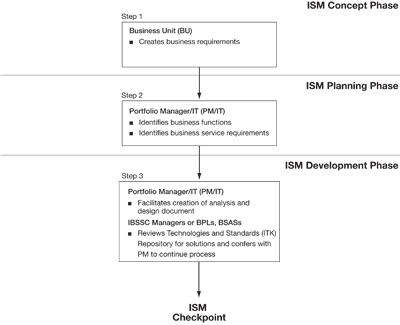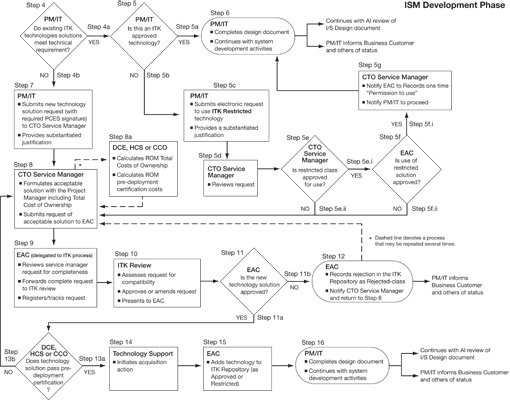Information Technology
Managing Software Technology Solutions - Software Approval Process and
Information Technology Kit
This article establishes the software approval (SA) process and the Information Technology Kit (ITK) as components of the
approach the Postal ServiceTM uses to manage its information technology software solutions, software development tools,
commercial off-the-shelf products (COTS), and other software used in the Information Technology infrastructure. Technology
solutions include those components, technical standards, products, and guidelines that are invoked in the design, creation,
and delivery of information technology (IT) solutions for the corporation. They are not in themselves a complete system
solution.
Policy
It is the intent of the Postal Service to provide a corporate-level view when selecting technologies used in applications that
support business solutions. To do this, during application design, technology will be selected from the software solutions
listed in the ITK Approved-class category. If a technology is in the ITK Restricted-class category, the SA process will be used
to determine the technology's use. In addition, the SA process will be used to add new technology solutions to the ITK.
Scope
The software approval process applies to the following:
• All Postal Service functional organizations, employees, suppliers, business partners, and contractors.
• All internal information technology solutions within the corporate technology infrastructure.
• All electronic data sources that interact with the internal Postal Service technology infrastructure.
About the SA Process
The SA process is the step-by-step discipline used to identify new or existing information technology solutions or to modify
existing corporate technology solutions. It provides a framework so that technology solutions developed and implemented for
one functional organization's needs will consider the overarching needs of the corporation and the impact of delivering such
solutions on the corporate IT infrastructure. (See Exhibit A, Solution Approval Process as Part of the ISM Process, and
Exhibit B, Solution Approval Process.)
For software solutions that require version-number control, a request to change the version number of an existing
Approved- or Restricted-class technology solution must follow the SA process. Different levels of version control for different
technology solutions are implemented within the ITK (see http://itk for details).
When the SA Process Starts
The SA process starts in Phase 3 of the Integrated Solution Methodology (see http://ism). By then, a functional organization's representative will have begun working with an IT portfolio manager (PM/IT) and other IT organizations to develop business solutions. The PM/IT initiates the SA process and accesses the ITK (http://itk) to see whether existing technology
solutions in the Approved or Restricted class meet the technical requirements established in ISM Phase 2, Planning.
|
If . . .
|
Then . . .
|
|
The ITK contains an Approved-class technology solution that
meets requirements,
|
System development activities continue.
|
|
The ITK contains a Restricted-class technology solution,
|
The SA process guides you through the steps needed to request
permission and gain approval to use the solution.
|
|
If the ITK does not contain a technology solution,
|
The SA process guides you through the steps needed to establish
an acceptable solution.
|
The SA process does not review code or track completed software development projects deployed within the coporation.
Benefits
For functional organizations:
• Reduced costs in the areas of purchasing technology solutions (when approved solutions are selected), support for the
application over its lifecycle, and integration of the solution into the corporate infrastructure.
• Step-by-step help and direction to identify, select, and implement standardized and IT-supported technology solutions.
• More rapid deployment of information technology solutions by leveraging the existing infrastructure.
For the Postal Service:
• Less fragmentation within the corporate information technology business solution environment.
• Reduced costs in the areas of training, maintenance, and operational support.
• The ability to leverage internal expertise.
About the ITK
The ITK provides the list of Postal Service technology solutions. These solutions are classified as Approved, Restricted,
and Obsolete/Rejected (see definitions, below). The ITK focuses on standards and software solutions and includes data
about technology solutions, such as the responsible IT service manager, details of the functionality, and applicability of the
technology solutions. The ITK, formerly known as the Integrated Tool Kit, is used to invoke the SA process and is available at
http://ITK.
Definitions of Classifications Used in the ITK
Approved Technology Solutions. Standards, products, or tools that are a strategic part of the technical infrastructure. Items
that have enterprise deployment, provide a full range of services in their category, have a known and articulated purchasing
strategy in place, and considered to be authorized without further approval.
Restricted. Standards, products, or tools that are isolated in the infrastructure. Items that are used to meet specific business needs, but for which general widespread deployment is not authorized; typically represent "one-of-a-kind" solutions that
are approved to meet narrow or relatively short-term needs; or that require an SA request to obtain permission to use.
Obsolete/Rejected. Technology solutions that the Enterprise Architecture Committee (EAC) has evaluated and rejected or
made obsolete. (This category is used by IT for tracking and analysis purposes and is not available for public review.)
Access to and Use of the ITK
|
Who can access
|
Type of access
|
Use
|
|
Anyone authorized to access the
Postal Service infrastructure.
|
Limited, automatic
|
Research Approved-class technology solutions.
|
|
Portfolio Managers, IT; Service
Managers, IT; EAC members.
|
Unlimited*
|
Research Approved- and Restricted-class technology solutions; initiate
requests to use Restricted-class technology solutions; initiate requests
for new technology solutions.
|
* Anyone may request unlimited access via eAccess at http://eAccess.
Information Technology Responsibilities
The vice president, Chief Technology Officer, who is responsible for providing the direction and requirements for establishing the Postal Service IT infrastructure and methods and tools for application development, has the following responsibilities:
1. Manages the introduction of all business solutions to the IT infrastructure, including hardware and platform technology
management.
2. Resolves technology solution disputes as presented by the Enterprise Architecture Committee (EAC).
3. Serves as final approval authority for the addition of new technology solutions to the ITK.
The manager, Technology Support, who also serves as the chair of the EAC, will do the following:
1. Execute delegated authority on behalf of Supply Management, Purchasing.
2. Assist in negotiating contractual fulfillment for SA-approved solutions.
Portfolio managers, as the interface between functional organizations and IT service managers, will evaluate, clarify, and
present functional organization business requirements to the appropriate IT service managers.
Integrated Business Solutions Services Center managers will do the following:
1. Use the functional business organization requirements document created by the PM/IT to confer with IT service managers to identify technical requirements.
2. Present selected technology solutions from the ITK to the IT service manager.
IT service managers will do the following:
1. Review requests to use Restricted-class technology solutions within their respective service domains.
2. Assess requests for applicability.
3. Notify the EAC of decisions affecting pending requests.
4. Formulate alternative solutions when required or desirable.
5. Submit requests for new technology solutions to the EAC within their respective service domains.
6. Approve the use of Restricted-class technology solutions within their respective service domains.
Functional Organization Responsibilities
Functional organization vice presidents and executive sponsors of information technology solutions are responsible for
the following:
1. Ensuring that their respective organizations work with their assigned PM/IT when considering technological solutions
for the IT infrastructure.
2. Following the SA process.
3. Using the ITK.
Exhibit A. Solution Approval Process as Part of the ISM Process

Exhibit B. Solution Approval Process


- Technology Support, Information Technology, 5-12-05
NOTICE
FAST is Getting Closer - All Drop Shipment Customers Must Register!
Drop Shipment Appointment System (DSAS) sign-on
IDs will not work in Facility Access and Shipment Tracking
(FAST). Customers must log on to PostalOne! at
www.usps.com/postalone and follow the instructions to
create a new account. All customers who make drop shipments into Postal ServiceTM facilities must register by July,
even if appointments are made by telephone.
For customers who already have a PostalOne! account,
contact the PostalOne! Customer Care Center at
800-522-9085 to complete the FAST registration.
FAST User Training and Technical Webinars Are
Underway
Training sessions are specifically for current DSAS Web
online users, while the Webinar sessions are targeted toward the technical side to prepare companies that plan to
use Web Services. Web Services replace the current batch
processing available in DSAS for customers.
Training - Seats are Available
The Postal Service launched FAST Train-the-Trainer
classes for customers in New York, New York, and
Madison, Wisconsin, and will continue to offer sessions
throughout May and June at select Postal Service training
facilities around the country. Companies may select up to
five people to participate in the Train-the-Trainer classes.
The Customer Training Registration Form can be downloaded from the Rapid Information Bulletin Board System
(RIBBS) at http://ribbs.usps.gov.
Webinars - Replays Available
The Technical Webinar Series began on April 29th. The
first Webinar included participation from 25 customers and
highlighted the technical steps for customers to deploy
Web Services. The second Webinar was targeted at software vendors to help them meet the needs of Web
Services customers. These sessions were recorded and
are available for playback for those not able to participate
on the original dates.
To attend the next session, follow the Webinar instructions posted on RIBBS at http://ribbs.usps.gov, click FAST/Surface Visibility, then Click Here for Additional Information
in the Document Repository. There you will find the
"Webinar 3 Instructions."
- Logistics Systems,
Operations, 5-12-05
To prevent against delays in delivery, customers and
mail acceptance personnel must ensure the following:
• PS Form 2976-A is not folded when inserted into PS
Form 2976-E.
• The barcode on PS Form 2976-A is completely visible through PS Form 2976-E.
- International Network Operations,
Network Operations Management, 5-12-05
| 